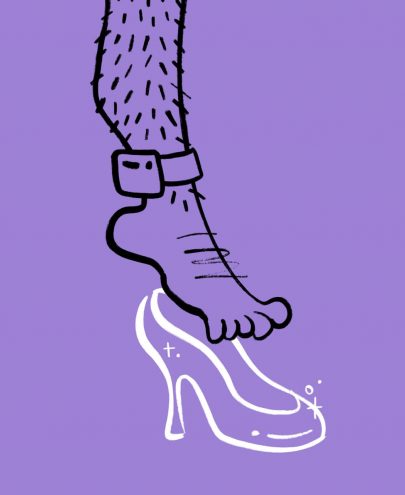Mar 17, 2016 etc
In 2004, Judith Collins described the Civil Union Bill as being “about gay marriage” and voted against it. How times have changed: nine years later, she voted in favour of same-sex marriage and in February, as Minister for Police and Corrections, she walked in the Pride Parade, along with uniformed police and Corrections officers.
The inclusion of JC’s PC brigade — police and Corrections — is hugely controversial. Some LGBTIQA people feel deeply uncomfortable watching police parade after traumatic experiences of police homophobia over the decades. Meanwhile, activist group No Pride In Prisons (NPIP) accuses the police of “pink-washing” — of using a rainbow-friendly image as a distraction from human rights violations, in this case, the poor police record of institutional racism. (It was NPIP — not anti-TPPA protestors as widely suggested — who glitter-bombed John Key at February’s Big Gay Out, to highlight what they see as the Prime Minister’s own pink-washing. For good measure, they glitter-bombed the Big Gay Out police stall, too.)
As for Corrections, NPIP is concerned about transwomen housed in male prisons, claiming they’re either kept in solitary confinement or having to “double bunk” with other prisoners; that at least two have been raped in the past year and that trans prisoners in general are at high risk of rape. The group very reasonably argues that Corrections doesn’t deserve high-profile rainbow endorsement such as Pride Parade inclusion while denying trans prisoners their rights.
In addition — a more difficult sell — NPIP calls for the abolition of incarceration altogether, and believes the police and Corrections should never be included in the parade.
On the other hand, most police and Corrections officers who march in the parade identify as LGBTIQA themselves and, while they could parade in civilian clothes, being out and in uniform is a hard-won right. Then again, their uniforms represent not their own but their organisation’s values, culture and policies. Which values and aesthetics belong in a contemporary Pride Parade?
The debate became news when police and Corrections officers marched in the parade for the first time last year and a Maori transwoman associated with NPIP had her arm badly broken by security staff while protesting against their inclusion. We like to kid ourselves that violence against our most marginalised groups for the supposed benefit of state agencies doesn’t happen any more: the irony of this particular assault taking place in public at the Pride Parade is bitter indeed.
When you’ve transformed from pariah to most popular, knowing how to manage all your new best friends takes a bit of getting used to.
Auckland Pride Festival Inc feels caught in the middle. When you’ve transformed from pariah to most popular, knowing how to manage all your new best friends takes a bit of getting used to. Their main principle is to be as inclusive as possible. “There are many people who in the past have not treated the rainbow community well, and could be excluded on that basis, but we’re trying to look forward,” says Pride board co-chair Kirsten Sibbit. Judith Collins springs to mind. But when a professional group’s official presence means some citizens feel excluded from even attending the parade, what is the appropriate response?
Inclusion is not favouring the larger group over the smaller, if that means prioritising the more powerful over the more vulnerable, the accepted over the marginalised. The Pride board belatedly apologised for the injury of the protester, and it inserted a useful statement in the 2016 parade guidelines that entries would “not be accepted from organisations whose policies and procedures discriminate against or fail to uphold the human rights of the Rainbow Community”. In January, the board decided that Corrections would not be allowed to march due to its treatment of trans prisoners, what Sibbit describes as the “fairly compelling reason” of its treatment of trans prisoners.
But three weeks later, Corrections officers did march. Sibbit says that in an intervening series of conversations, Corrections proved themselves willing to improve things in the “tricky area” of trans-prisoner management. However, no agreement has been reached about what those improvements might be; instead, Corrections and Pride agreed that Pride would act as a link between advocacy groups and Corrections to discuss potential actions. Thus far, that community liaison is proving difficult: “Some people are more willing to talk to us than others,” says Sibbit dryly. This is unsurprising, given that Pride’s inclusion of Corrections in the parade was viewed as such a hostile move that 300-odd protesters turned up on Karangahape Rd on parade day, some of whom successfully disrupted the parade.
Why didn’t the Pride board offer parade inclusion for police and Corrections as a reward for tangible change rather than simply for promises? “That’s an interesting question,” says Sibbit. The board believes the way to achieve change as quickly as possible is “to be collaborative, not combative”. Further, she says presenting LGBTIQA people, including Corrections officers, as out at work “can only be good for the rainbow community more broadly”. But such presentations are not good — in fact, they could be downright dangerous — if they give a false impression that the organisations represented are empathetic to all LGBTIQA communities. Rumour has it that some Corrections officers would have welcomed a clash with protesters. A Corrections parade participant later wrote on the NZ Police Facebook page: “I know the others that marched with me tonight would like to join me in thanking you guys for having our backs… one team kotahitanga.” Wider LGBTIQA solidarity appears to be a lower priority than loyalty to employers. So what should be the criteria for parade inclusion, and what’s too nit-picking? NPIP spokesperson Sophie Morgan believes the parade should be about “queer struggle, queer passion, queer anger”. Anachronistic? So are our continuing homophobia, violence and high suicide rates.
It seems clear, at least, that the board should follow their own new criterion next time round: inclusion should be reserved for those who actually uphold rainbow community rights, not those who don’t, no matter how much they might want to.





